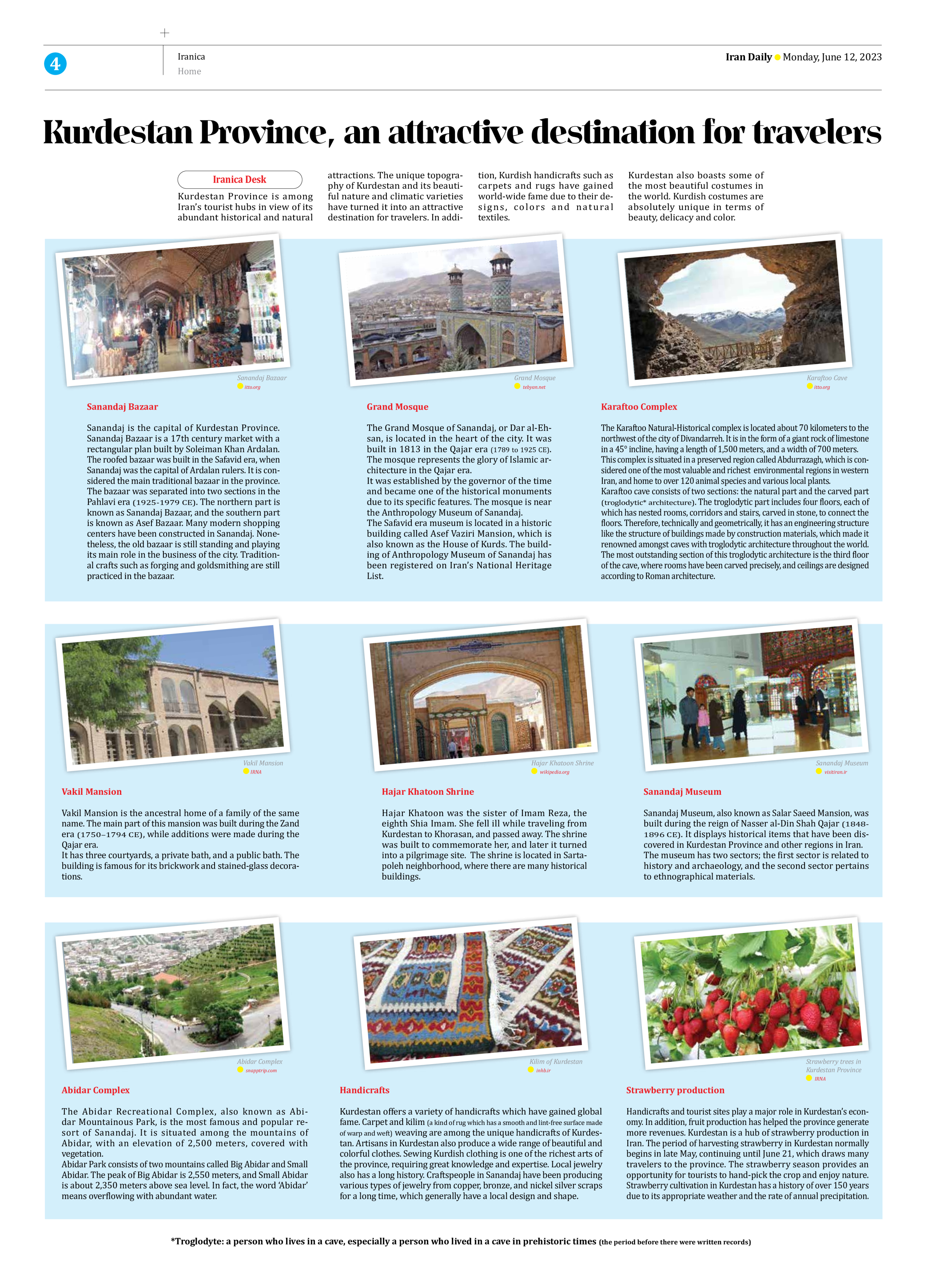
Kurdestan Province, an attractive destination for travelers
Kurdestan Province is among Iran’s tourist hubs in view of its abundant historical and natural attractions. The unique topography of Kurdestan and its beautiful nature and climatic varieties have turned it into an attractive destination for travelers. In addition, Kurdish handicrafts such as carpets and rugs have gained world-wide fame due to their designs, colors and natural
textiles.
Sanandaj Bazaar
Sanandaj is the capital of Kurdestan Province. Sanandaj Bazaar is a 17th century market with a rectangular plan built by Soleiman Khan Ardalan. The roofed bazaar was built in the Safavid era, when Sanandaj was the capital of Ardalan rulers. It is considered the main traditional bazaar in the province. The bazaar was separated into two sections in the Pahlavi era (1925-1979 CE). The northern part is known as Sanandaj Bazaar, and the southern part is known as Asef Bazaar. Many modern shopping centers have been constructed in Sanandaj. Nonetheless, the old bazaar is still standing and playing its main role in the business of the city. Traditional crafts such as forging and goldsmithing are still practiced in the bazaar.
Grand Mosque
The Grand Mosque of Sanandaj, or Dar al-Ehsan, is located in the heart of the city. It was built in 1813 in the Qajar era (1789 to 1925 CE). The mosque represents the glory of Islamic architecture in the Qajar era.
It was established by the governor of the time and became one of the historical monuments due to its specific features. The mosque is near the Anthropology Museum of Sanandaj.
The Safavid era museum is located in a historic building called Asef Vaziri Mansion, which is also known as the House of Kurds. The building of Anthropology Museum of Sanandaj has been registered on Iran’s National Heritage
List.
Karaftoo Complex
The Karaftoo Natural-Historical complex is located about 70 kilometers to the northwest of the city of Divandarreh. It is in the form of a giant rock of limestone in a 45° incline, having a length of 1,500 meters, and a width of 700 meters.
This complex is situated in a preserved region called Abdurrazagh, which is considered one of the most valuable and richest environmental regions in western Iran, and home to over 120 animal species and various local plants.
Karaftoo cave consists of two sections: the natural part and the carved part (troglodytic* architecture). The troglodytic part includes four floors, each of which has nested rooms, corridors and stairs, carved in stone, to connect the floors. Therefore, technically and geometrically, it has an engineering structure like the structure of buildings made by construction materials, which made it renowned amongst caves with troglodytic architecture throughout the world. The most outstanding section of this troglodytic architecture is the third floor of the cave, where rooms have been carved precisely, and ceilings are designed according to Roman architecture.
Vakil Mansion
Vakil Mansion is the ancestral home of a family of the same name. The main part of this mansion was built during the Zand era (1750–1794 CE), while additions were made during the Qajar era.
It has three courtyards, a private bath, and a public bath. The building is famous for its brickwork and stained-glass decorations.
Hajar Khatoon Shrine
Hajar Khatoon was the sister of Imam Reza, the eighth Shia Imam. She fell ill while traveling from Kurdestan to Khorasan, and passed away. The shrine was built to commemorate her, and later it turned into a pilgrimage site. The shrine is located in Sartapoleh neighborhood, where there are many historical buildings.
Sanandaj Museum
Sanandaj Museum, also known as Salar Saeed Mansion, was built during the reign of Nasser al-Din Shah Qajar (1848-1896 CE). It displays historical items that have been discovered in Kurdestan Province and other regions in Iran.
The museum has two sectors; the first sector is related to history and archaeology, and the second sector pertains to ethnographical materials.
Abidar Complex
The Abidar Recreational Complex, also known as Abidar Mountainous Park, is the most famous and popular resort of Sanandaj. It is situated among the mountains of Abidar, with an elevation of 2,500 meters, covered with
vegetation.
Abidar Park consists of two mountains called Big Abidar and Small Abidar. The peak of Big Abidar is 2,550 meters, and Small Abidar is about 2,350 meters above sea level. In fact, the word ‘Abidar’ means overflowing with abundant water.
Handicrafts
Kurdestan offers a variety of handicrafts which have gained global fame. Carpet and kilim (a kind of rug which has a smooth and lint-free surface made of warp and weft) weaving are among the unique handicrafts of Kurdestan. Artisans in Kurdestan also produce a wide range of beautiful and colorful clothes. Sewing Kurdish clothing is one of the richest arts of the province, requiring great knowledge and expertise. Local jewelry also has a long history. Craftspeople in Sanandaj have been producing various types of jewelry from copper, bronze, and nickel silver scraps for a long time, which generally have a local design and shape.
Strawberry production
Handicrafts and tourist sites play a major role in Kurdestan’s economy. In addition, fruit production has helped the province generate more revenues. Kurdestan is a hub of strawberry production in Iran. The period of harvesting strawberry in Kurdestan normally begins in late May, continuing until June 21, which draws many travelers to the province. The strawberry season provides an opportunity for tourists to hand-pick the crop and enjoy nature. Strawberry cultivation in Kurdestan has a history of over 150 years due to its appropriate weather and the rate of annual precipitation.
*Troglodyte: a person who lives in a cave, especially a person who lived in a cave in prehistoric times (the period before there were written records)
Kurdestan also boasts some of the most beautiful costumes in the world. Kurdish costumes are absolutely unique in terms of beauty, delicacy and color.







